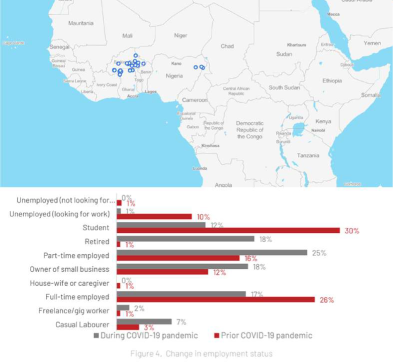Challenge
The COVID-19 Situational Analysis project, implemented by iMMAP, provides the U.S. Agency for International Development’s Bureau of Humanitarian Assistance (USAID/ BHA) with high-quality data and insights on the humanitarian impacts of COVID-19 to inform donor responses. But strict COVID-19 travel restrictions limited the ability of USAID/BHA and other humanitarian actors to access and monitor conditions in vulnerable communities around the world.
Solution
The COVID-19 Situational Analysis project used Premise to collect data from regions with limited humanitarian access in Burkina Faso, the Democratic Republic of the Congo (DRC), and Nigeria. Premise Contributors gathered a mix of survey and interview data to understand how COVID-19 was impacting people’s lives and livelihoods.
The COVID-19 Situational Analysis project asked Contributors to:
- Assess perceptions and knowledge of COVID-19 and government-mandated restrictions (Burkina Faso)
- Identify factors affecting vaccine hesitancy (Burkina Faso, DRC)
- Assess the effects of COVID-19 on livelihoods, employment, incomes, and coping mechanisms (Burkina Faso, DRC, Nigeria)
- Determine the extent to which certain businesses in the informal sector (e.g., food kiosks, salons/barbers, petty traders) have been impacted by COVID-19 restrictions and whether they were recovering once mandates began easing (Nigeria)

Findings
Data collected by Premise gave the COVID-19 Situational Analysis project clear insight into how the COVID-19 pandemic continues to affect people’s lives and livelihoods. iMMAP and USAID/BHA gained a nuanced picture of the impact on employment, income, and coping strategies — and high-resolution data that allowed for segmentation by age, gender, living situation, and financial situation, among other factors.
In northeastern Nigeria, for example, Premise data showed that while COVID-19 restrictions resulted in many people losing their livelihoods, those engaged in informal employment and those who traveled for work were especially impacted. The loss of livelihoods and income compounded existing vulnerabilities, in particular among disadvantaged populations. Premise data will help USAID/BHA better safeguard against vulnerabilities and strengthen social protection for both health and livelihoods in Nigeria, as well as in Burkina Faso and the DRC.
Implications:
With the observations gained from Premise, the COVID-19 Situational Analysis project was able to provide USAID/BHA and other humanitarian aid actors with data to:
- Evaluate and improve public health messaging aimed at infection prevention
- Improve public health messaging to increase COVID-19 vaccine uptake
- Understand COVID-19’s impact on employment, income, and coping mechanisms, and thus inform the design of livelihood and resilience programming that can go beyond emergency response
